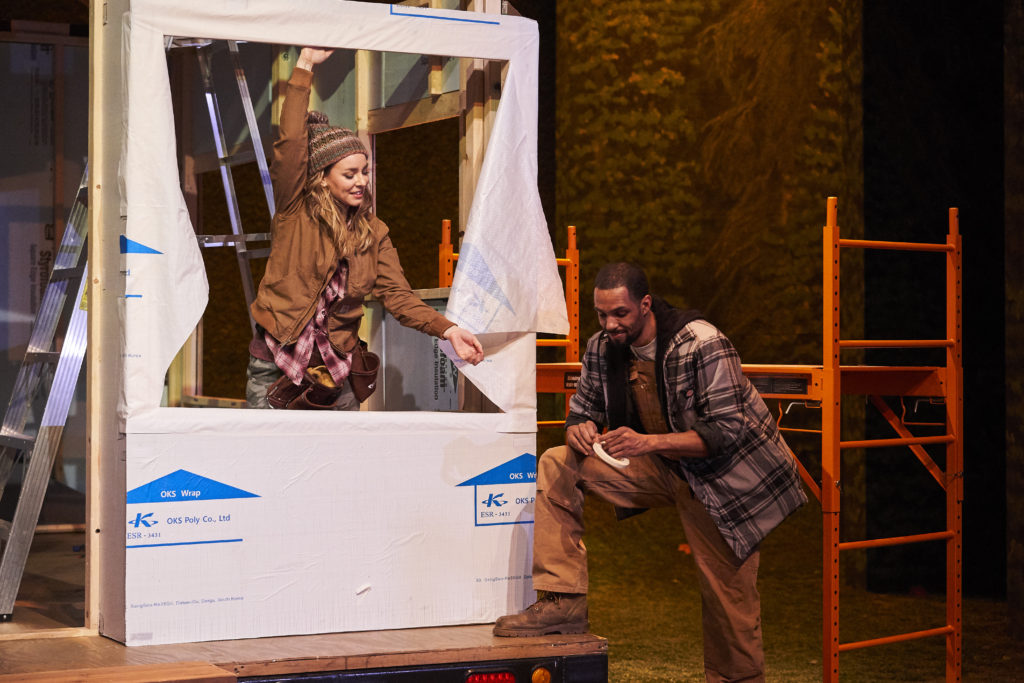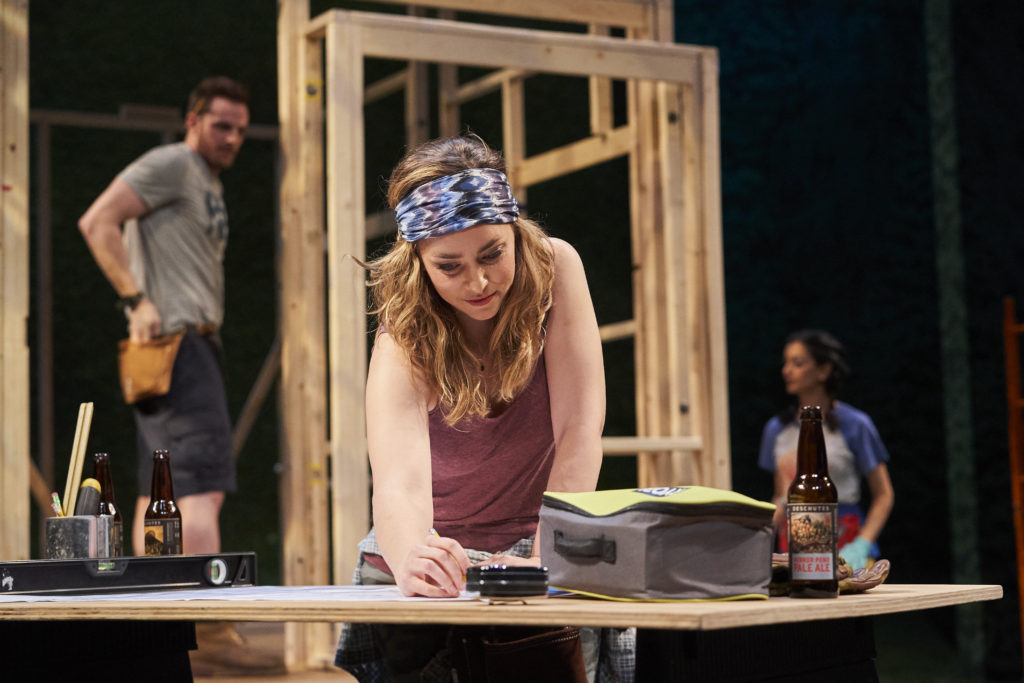by Dan Polletta |March 28, 2019
These days a popular book is advocating that if an object doesn’t bring you joy, then you should throw it away. Downsizing may make your life less cluttered, but will it really make it better?
Playwright Chelsea Marcantel examines that question in her comedy “Tiny Houses,” which received its world premiere earlier this week at Cleveland Play House and is a co-production with Cincinnati Playhouse in the Park. Staged by CPH’s artistic director Laura Kepley, the comedy follows a couple that decides a cross-country move into a 200-square-foot home is the path to fulfillment.
The tiny house movement began in the late 1990s and has spawned quite a bit of media coverage, including a couple of television series dedicated to the phenomenon.

“The tiny house movement is kind of a perfect storm of economic and environmental action. Tiny house people believe the most important things in life are experiences and relationships, not ‘stuff.’ You don’t need to have a bunch of stuff and the 30-year mortgage to feel good about yourself. The idea is to get rid of all the things that are making you anxious and collecting dust. Pare your life down to the essentials, live in a small space and then you can prioritize the other aspects of your life that don’t have to do with consumerism and commercialism, “ Marcantel said.
The playwright became interested in tiny houses after watching a documentary about it with her husband.
“He said: ‘Isn’t that an interesting idea? Maybe we should get rid of all of our stuff and move into a tiny house in the middle of the woods.’ I said: ‘We already live in a one bedroom apartment in New York. We already live in a tiny house. I don’t know how much less stuff we can possibly have,” Marcantel said.
While Marcantel wasn’t ready to make the move to that small of a dwelling, it did make her consider what it said about those who would.
“It started to make me think that we all have value systems. We all have things that we say we value in life and the way I want to live my life reflects the things that I value. Tiny house people live in that statement of values. They live in a physical structure that represents what is important to them. I thought, ‘that’s so interesting,’ so that was the germ of the whole idea for me,” Marcantel said.

“Tiny Houses” had its first public reading in 2016 at the Chautauqua Theatre Company’s New Play Workshop. Two years later, it was further developed in CPH’s New Ground Theatre Festival, where it received the Roe Green Award, which is given each year to honor outstanding achievement in playwriting. Marcantel said the time she spent in Cleveland in 2018 at New Ground made her excited to bring “Tiny Houses” back to CPH for its world premiere.
“The reading was kind of a test run to see what the audience thought, and if they would respond to it well. It had such a great response and went so well, it had so much laughter and there were so many great comments and conversations. It seemed like the Cleveland Playhouse Audience responds to this play, so let’s do it on a bigger scale.”
Marcantel said the CPH audience that attending the New Ground reading of “Tiny Houses” seemed particularly interested in an unusual piece of business that happens over the course of the play.
“One of the best and most exciting things about the play is the physical design aspect of it. Actors build a house in a play with no intermission. Over the course of 90 minutes, they go from a bare stage to a tiny house. It seemed like the audience really wanted to see that with their own eyes,” she said.
In her research, Marcantel discovered something that isn’t well-publicized about tiny houses.
“A lot of people get excited about them in the beginning, but it is actually a very big challenge to live in them. Many people who build tiny houses don’t stay in them very long, which is a lesser-known fact of the industry. You don’t see the epilogue when you watch the shows on TV of how strained relationships can become and how people can start to feel claustrophobic. The play deals with the downsides as well, it’s not all perfect Instagram posts and rosy glasses when it comes to living in a tiny house,” Marcantel said.
Marcantel exposes those struggles through the plays two main characters, Cath, who leaves her well-paying but high pressure job in finance in New York to move to Oregon to build a tiny house with her boyfriend, Bode.
“When Cath and Bode begin building this house they discover that though they have gotten rid of a lot of physical belongings, what that has actually done is throw into relief some of the obstacles in their relationship. The further they get along with building the house and all the stress that comes with the project, the more they realize where their own cracks are in their relationship. The more these forces swirl, the more they realize we were going to simplify things, it actually has turned into a complex endeavor,” Marcantel said.
“Tiny Houses” allows Marcantel to explore a larger subject that she has dealt with her other plays, including “Airness,” which digs into the world of competitive, air-guitar playing and “Everything is Wonderful,” which is set in an Amish community.
“I like to write about humans as small-group primates. The idea that there are groups of people who have interesting hobbies or value systems or ways of life that are part of American life that may not get as much attention as larger groups. I also think the other thing that fascinates me is watching audience members learn about these groups of people and walk out of the theater saying, ‘I didn’t know that existed’ and maybe going home to look it up on their own. My favorite thing is if someone tells me they saw one of my plays and then they went home and fell down an internet wormhole learning about that group of people. That’s the highest praise I can get,” Marcantel said.

Marcantel hopes audiences come away from “Tiny Houses” thinking about what home, no matter the size, really means.
“It’s not explicitly stated, but there’s definitely a message about home being a state of mind and being more about relationships, than a physical structure or place. You can have the biggest house in the world and not feel at home and you can have a tiny house and not feel at home. It’s more about who you are surrounding yourself with and not what you are surrounding yourself with,” Marcantel said.






